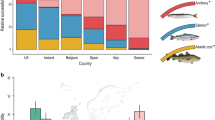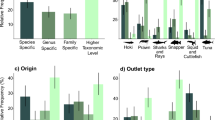Abstract
Radioactive contamination from the Fukushima disaster has undermined the seafood caught around the area. Approximately 20 % of general consumers are reported to avoid seafood from Fukushima, even though it has not been found to exceed the Japanese criteria of radioactivity since April 2015. Based on a survey of more than 2000 domestic consumers in Japan, this study investigated the characteristics of those who boycotted safe marine products from the devastated region, using conjoint analysis with a latent class model. The attributes (levels) included price, three prefectural origins (including Fukushima and adjacent prefectures), six local origins, and two ecolabels targeting white fish meat. The latent class model divided participants into three classes: boycotters (27.5 %), consumers devaluing cod (41.0 %), and ordinary consumers (31.5 %). Boycotters neither believed the radioactive test results from any entity nor bought seafood frequently. Furthermore, they tended not to recognize the Marine Stewardship Council, earned more, and were relatively older than the average.



Similar content being viewed by others
References
Ariji M, Matsui T (2012) Grasp of consumer needs and merchandizing strategy for changing fisheries into 6th industry: the case of Miyazu city, Kyoto. J Int Fish 11:1–11 (in Japanese with English abstract)
Aruga K (2016) Consumer responses to food produced near the Fukushima nuclear plant. Environ Econ Policy Stud 19:677–690
Consumer Affairs Agency and Ministry of Agriculture, Forestry and Fisheries of Japan (2004) Guidebook for quality labeling for food depend on JAS law, Tokyo, p 1–34 (In Japanese)
Frank B, Schvaneveldt S (2014) Self-preservation vs. collective resilience as consumer responses to national disasters: a study on radioactive product contamination. J Conting Crisis Manage 22:197–208
Fukushima Prefecture (2009) Statistics of catch of marine fisheries in Fukushima prefecture, Fukushima, p 1–90 (In Japanese)
Fukushima Prefecture (2015) Vision of fisheries experiment and research for early recovery for fisheries industry, Fukushima, p 1–16 (In Japanese)
Fukushima Prefecture (2017a) Handbook of fisheries in Fukushima (Fukushima-ken suisan youran), Fukushima, p 1–110 (In Japanese)
Fukushima Prefecture (2017b) Statistics of catch of marine fisheries in Fukushima prefecture, Fukushima, p 1–94 (In Japanese)
Hayakawa Y (2014) Radioactive contamination and health risk evaluation from the Fukushima Daiichi nuclear power plant accident in March, 2011. Annu Rep Fac Educ Gunma Univ 62:35–50 (in Japanese with English Abstract)
Japan Patent Office, Regional Brands in JAPAN (2014) Regional collective trademarks, In: Ministry of Economy, Trade and Industry (eds), Tokyo, p 1–176
Loureiro ML, Lotade J (2005) Do fair trade and eco-labels in coffee wake up the consumer conscience? Ecol Econ 53:129–138
Loureiro ML, McCluskey JJ, Mittelhammer RC (2002) Will consumers pay a premium for ecolabeled apples? J Consumer Aff 36:203–219
McKendree M, Ortega D, Widmar N and Wang H (2013) Consumer perceptions of seafood industries in the wake of the deepwater horizon oil spill and Fukushima Daiichi nuclear disaster, Staff Paper of Department of Agricultural, Food and Resource Economics, Michigan State University 1–22
Ministry of Education, Culture, Sports, Science, and Technology Japan (2012) Qualitative information regarding damage by so-called “harmful rumor” (Appendix 1–2), Conflict review board for nuclear damages compensation (The 29th), Tokyo, p 1–159 (in Japanese)
Miyata T (2010) Fundamental issues of branding strategy for seafood. In: Lou X et al (eds) Theory and practice for branding strategy of seafood: marketing for creating local resources with value. Hokutoshobo, Tokyo, pp 281–302 (In Japanese)
Miyata T, Wakamatsu H (2015) Irrational reputational damage on wakame seaweed in Sanriku district after the Fukushima nuclear disaster: revealed preference by auction experiment. Fish Sci 81:995–1002
Miyata T, Wakamatsu H (2016) Mitigating irrational reputational damage to marine products from radiation contamination. Fish Sci 82:983–989
Pacifico D, Yoo HI (2012) lclogit: a Stata module for estimating latent class conditional logit models via the expectation-maximization algorithm. Stata J 13:625–639
Takahashi K (2015) Fishers conveying the current status of Fukushima: counteractivity against reputational damage. J Fish Boat Syst Eng Assoc Jpn 15:30–35 (In Japanese)
Uchida H, Onozaka Y, Morita T, Managi S (2014) Demand for ecolabeled seafood in the Japanese market: a conjoint analysis of the impact of information and interaction with other labels. Food Policy 44:68–76
Ujiie K (2012) Consumer’s evaluation on radioactive contamination of agricultural products in Japan. Jpn Food Syst Res 19:142–155 (In Japanese with English Abstract)
Wada T, Nemoto Y, Shimamura S, Fujita T, Mizuno T, Sohtome T, Kamiyama K, Morita T, Igarashi S (2013) Effects of the nuclear disaster on marine products in Fukushima. J Environ Radioact 124:246–254
Wakamatsu H, Miyata T (2017) Reputational damage and the Fukushima disaster: an analysis of seafood in Japan. Fish Sci 83:1049–1057
Wakamatsu H, Anderson CM, Uchida H, Roheim CA (2017) Pricing ecolabeled seafood products with heterogeneous preferences: an auction experiment in Japan. Mar Resour Econ 32:277–294
Wallmo K, Edwards S (2008) Estimating non-market values of marine protected areas: a latent class modeling approach. Mar Resour Econ 23:301–323
Acknowledgements
This study was funded by the Fisheries Agency, Ministry of Agriculture, Forestry, and Fisheries, Japan. We would like to thank Editage (www.editage.jp) for English language editing.
Author information
Authors and Affiliations
Corresponding authors
Rights and permissions
About this article
Cite this article
Miyata, T., Wakamatsu, H. Who refuses safe but stigmatized marine products due to concern about radioactive contamination?. Fish Sci 84, 1119–1133 (2018). https://doi.org/10.1007/s12562-018-1250-1
Received:
Accepted:
Published:
Issue Date:
DOI: https://doi.org/10.1007/s12562-018-1250-1





